How To Use a Compass - Illustrated Tutorial, page 3
Unfortunately, sometimes, for some quite often, it is even more complicated. There is something called magnetic declination. And then, for hiking, you would not use orienteering maps. And this is the issue for lesson 3.
Magnetic Declination
You see, the compass is pointing towards the magnetic northpole, and the map is pointing towards the geographic northpole, and that is not the same place.
Each of the Norths

To make things even more complicated, there is on most hiking-maps something (that is very useful) called the UTM-grid. This grid does not have a real north pole, but in most cases, the lines are not too far away from the other norths. Since this grid covers the map, it is convenient to use as meridians.
On most orienteering maps (newer than the early 70's), this is corrected, so you will not have to worry about it. But on topographic maps, this is a problem.
First, you'll have to know how large the declination is, in degrees. This depends on where on the earth you are. So you will have to find out before you leave home. Or somewhere on the map, it says something about it. One thing you have to remember in some areas, the declination changes significantly, so you'll need to know what it is this year.
If you are using a map with a "UTM-grid", you want to know how this grid differs from the magnetic pole.
When you are taking out a course, you will do that more or less as described in lesson 2.
CAUTION! But this time, you must also look out so that you do not align the orienting lines with the grid lines pointing west or east, or south for that matter. When you have taken out a course like you have learned, you must add or subract an angle, and that angle is the angle you found before you left home, the angle between the grid lines or meridians and the magnetic north.
The directions

The declination is given as e.g. "15 degrees east." When you look at the figure, you can pretend that plus is to the right, or east, and minus is to the left and west. Like a curved row of numbers. So when something is more than zero you'll subtract to get it back to zero. And if it is less, you'll add. So in this case you'll subtract 15 degrees to the azimuth, by turning the compass housing, according to the numbers on the housing. Now, finally, the direction of travel-arrow points in the direction you want to go. Again, be careful to aim at some distant object and off you go.
You may not need to find the declination before you leave home, actually. There is a fast and pretty good method to find the declination whereever you are. This method has also the advantage that corrects for local conditions that may be present. This is what you do:
1. Determine by map inspection the grid azimuth from your location to a
know, visible, distant point. The further away, the more accurate it gets.
This means you have to know where you are, and be pretty sure about one
other feature in the terrain.
2. Sight on that distant point with the compass and note the magnetic azimuth.
You do that by turning the compass housing so that it is aligned with the
needle. You may now read the number from the housing where it meets the
base of the direction of travel-arrow.
3. Compare the two azimuths. The difference is the declination.
4. Update as necessary. You should not need to do this very often, unless
you travel in a terrain with lots of mineral deposits.
Uncertainty
You cannot always expect to hit exactly what you are looking for. In fact, you must expect to get a little off course. How much you get off course depends very often on the things around you. How dense the forest is, fog, visibility is a keyword. And of course, it depends on how accurate you are. You do make things better by being careful when you take out a course, and it is important to aim as far ahead as you can see.
Uncertainty is One Tenth

In normal forest conditions we say that as a rule of thumb, the uncertainty is one tenth of the distance traveled. So if it is like in the figure, you go 200 meters on course, it is possible that you end up a little off course, 20 meters or so. If you are looking for something smaller than 20 meters across, there is a chance you'll miss. If you want to hit that rock in our example you'll need to keep the eyes open! In the open mountain areas, things are of course a lot easier when you can see far ahead of you.
This was the last of the lessons you should know. But more lessons are upcoming. Now it is time to log out and get into the backyard, and then backcountry. Try it out! That is after all, the only way to learn this properly. Good Luck!